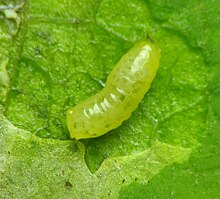
The Tachinidae are a large and variable family of true flies within the insect order Diptera, with more than 8,200 known species and many more to be discovered. Over 1,300 species have been described in North America alone. Insects in this family commonly are called tachinid flies or simply tachinids. As far as is known, they all are protelean parasitoids, or occasionally parasites, of arthropods, usually other insects. The family is known from many habitats in all zoogeographical regions and is especially diverse in South America.

A leaf miner is any one of numerous species of insects in which the larval stage lives in, and eats, the leaf tissue of plants. The vast majority of leaf-mining insects are moths (Lepidoptera), sawflies, and flies (Diptera). Some beetles also exhibit this behavior.

The Agromyzidae are a family of flies, commonly referred to as the leaf-miner flies for the feeding habits of their larvae, most of which are leaf miners on various plants. It includes roughly 2,500 species, they are small, some with wing length of 1 mm. The maximum size is 6.5 mm. Most species are in the range of 2 to 3 mm.

Phthorimaea operculella, also known as the potato tuber moth or tobacco splitworm, is a moth of the family Gelechiidae. It is an oligophagous insect that feeds on the plant family Solanaceae and is especially known for being a major pest of potato crops. Currently farmers utilize insecticides, parasites, and sprinkler irrigation in order to prevent P. operculella from infesting their croplands.

Delia flies are members of the Anthomyiidae family within the superfamily Muscoidae. The identification of different species of Delia can be very difficult for non-specialists as the diagnostic characteristics used for immature and/or female specimens may be inconsistent between species. Past taxonomic keys were not as comprehensive in their identification of Delia specimens; they were either too reliant on genetic characteristics, focused solely on a specific life stage, or were focused only on certain species. However current taxonomic keys aim to be more thorough by not only including morphological diagnostics for males, females, and immature specimens of various species, but also their genetic make-up or molecular barcode.
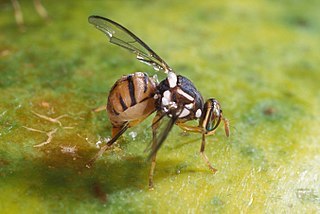
Bactrocera dorsalis, previously known as Dacus dorsalis and commonly referred to as the oriental fruit fly, is a species of tephritid fruit fly that is endemic to Southeast Asia. It is one of the major pest species in the genus Bactrocera with a broad host range of cultivated and wild fruits. Male B. dorsalis respond strongly to methyl eugenol, which is used to monitor and estimate populations, as well as to annihilate males as a form of pest control. They are also important pollinators and visitors of wild orchids, Bulbophyllum cheiri and Bulbophyllum vinaceum in Southeast Asia, which lure the flies using methyl eugenol.

Anthonomus eugenii is known as the pepper weevil. This beetle feeds and lays eggs on plants in the genus Capsicum and a few species in the genus Solanum. A. eugenii is native to Mexico, however, it is an important pest of Capsicum in Florida, Puerto Rico, and Central America.
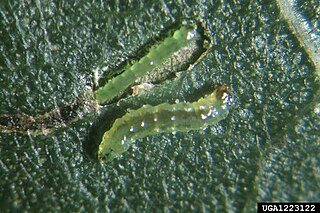
The serpentine leaf miner is the larva of a fly, Liriomyza brassicae, in the family Agromyzidae, the leaf miner flies. It mines wild and cultivated plants, such as cabbage, broccoli, cauliflower and Chinese broccoli.
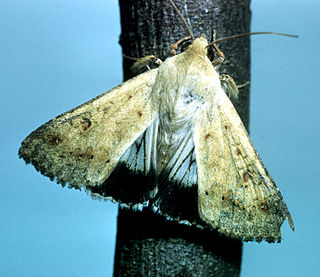
Helicoverpa punctigera, the native budworm, Australian bollworm or Chloridea marmada, is a species of moth in the family Noctuidae. This species is native to Australia. H. punctigera are capable of long-distance migration from their inland Australian habitat towards coastal regions and are an occasional migrant to New Zealand.

Chloridea virescens, commonly known as the tobacco budworm, is a moth of the family Noctuidae found throughout the eastern and southwestern United States along with parts of Central America and South America.

Phytomyza ilicis, the holly leaf miner, is a leaf mining fly in the family Agromyzidae, whose larvae burrow into leaves of the holly tree leaving characteristic pale trails or leaf mines.
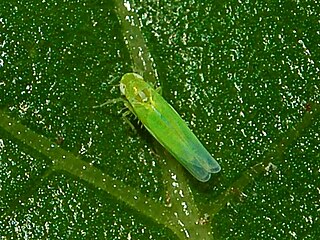
Empoasca decipiens is a species of leafhopper belonging to the family Cicadellidae subfamily Typhlocybinae. The adults reach 3–4 millimetres (0.12–0.16 in) of length and a are homogenously green with whitish markings on its pronotum and vertex. E. decipiens is commonly referred to as the “green leafhopper” because of its colouration. The absence of clear stripes along the forewings can easily distinguish it from the similar leafhopper species E. vitis, but distinguishing it from other leafhoppers with the same colouration requires examination under a microscope. It is present in most of Europe, in the eastern Palearctic realm, in North Africa, in the Near East, and in the Afrotropical realm. Both nymphs and adults of this small insect are considered to be a very destructive pests on field crops, vegetables and greenhouse plants.

Samea multiplicalis, the salvinia stem-borer moth, is an aquatic moth commonly found in freshwater habitats from the southern United States to Argentina, as well as in Australia where it was introduced in 1981. Salvinia stem-borer moths lay their eggs on water plants like Azolla caroliniana, Pistia stratiotes, and Salvinia rotundifolia. Larval feeding on host plants causes plant death, which makes S. multiplicalis a good candidate for biological control of weedy water plants like Salvinia molesta, an invasive water fern in Australia. However, high rates of parasitism in the moth compromise its ability to effectively control water weeds. S. multiplicalis larvae are a pale yellow to green color, and adults develop tan coloration with darker patterning. The lifespan, from egg to the end of adulthood is typically three to four weeks. The species was first described by Achille Guenée in 1854.
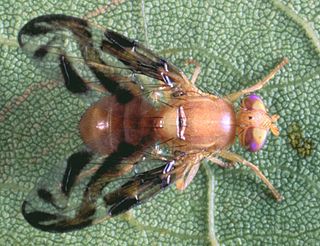
Anastrepha suspensa, known as the Caribbean fruit fly, the Greater Antillean fruit fly, guava fruit fly, or the Caribfly, is a species of tephritid fruit fly. As the names suggest, these flies feed on and develop in a variety of fruits, primarily in the Caribbean. They mainly infest mature to overripe fruits. While thought to have originated in Cuba, the Caribbean fruit fly can now also be found in Florida, Hispaniola, and Puerto Rico.

Phytomyza horticola is a species of leaf-mining fly in the family Agromyzidae of the order Diptera. For a time it was treated as Chromatomyia horticola, but its original name has been restored after genus Chromatomyia was synonymized with Phytomyza. The species is a pest of high economic importance affecting the vegetable crops in temperate and tropical regions.

Scaptomyza flava is an herbivorous leaf mining fly species in the family Drosophilidae. In Latin, flava means golden or yellow. The fly is amber to dark brown in color and approximately 2.5 mm in length. In Europe and New Zealand the larvae are pests of plants in the order Brassicales, including arugula, brassicas, broccoli, Brussels sprouts, bok choy, cabbage, canola, cauliflower, horseradish, kale, kohlrabi, napa cabbage, nasturtium, radish, rapini, rutabaga, turnip, wasabi and watercress. In New Zealand, its range has expanded to include host species that are intercropped with salad brassicas, including gypsophila, otherwise known as baby's breath, which is in the pink family (Caryophyllaceae) and the pea in the Fabaceae. More typically, S. flava is oligophagous within the Brassicales. Scaptomyza are unusual within the Drospophilidae because the group includes species that are truly herbivorous. Other herbivorous drosophilids include D. suzukii, which attacks fruit very early during ripening and species within the genus Lordiphosa, from Africa and Asia, which also include leaf miners. Most drosophilids feed on microbes associated with decaying vegetation and sap fluxes.
Liriomyza sativae, commonly known as the vegetable leaf miner, is a species of insect, a fly in the family Agromyzidae. The larvae of this fly mine the leaves of a range of vegetables and weeds, but seem to favour plants in the families Cucurbitaceae, Fabaceae and Solanaceae.
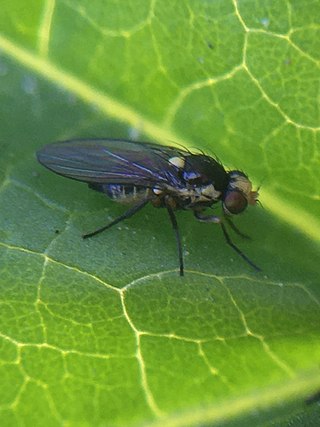
Liriomyza huidobrensis, commonly known as the pea leaf miner, is a species of insect, a fly in the family Agromyzidae. The larvae of this fly mine the leaves and stems of peas and a range of other vegetables. It is also known as the serpentine leaf miner, but this name is also used for a closely related species, Liriomyza brassicae.
Mallophora ruficauda is a species of parasitic robber fly in the family Asilidae, endemic to South and Central America. Like other robber flies, M. ruficauda is known for its aggressive behavior and predation upon other insects, especially bees. M. ruficauda mimics a bumblebee to fool predators into thinking it has a painful sting and is not worth eating.

Anastrepha fraterculus, known as the South American fruit fly, is a fruit fly species from the genus Anastrepha. A. fraterculus is a polyphagous, frugivorous fly that is a significant pest of commercial fruit production in South America.

